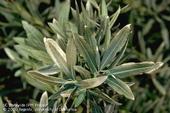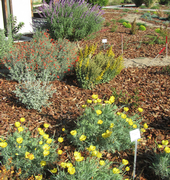
(Credit: K Windbiel-Rojas)
Plantains are common weeds in lawns, athletic fields, ornamental plantings, roadsides, and pastures. Two species, broadleaf and buckhorn plantains (Plantago major and P. lanceolate) are commonly found throughout California year-round.
Plantains grow well in irrigated turf and lawns that are frequently mowed since they grow low to the ground. They can be a major pest for turfgrass managers since they grow in dense clumps, creating both an aesthetic and tripping hazard in turf. When plantains infest ornamental plantings, they can crowd out desired plants.
These weeds are difficult to control because they can resprout from the crown, even after it's cut off. Early removal of seedlings before they...

Days are getting shorter and evenings cooler as winter approaches. Sweater weather also means a change in the to-do list around the yard.
Here are a few things to consider when preparing your landscapes and gardens for winter.
Frost
- Protect sensitive plants from cold injury when freezing or frost is predicted. Cover plants with cloth or a similar material at night, leaving the covers open at the bottom so heat from soil can help warm plants.
- When frost or freezing is expected, irrigate dry topsoil at least 3 days before the cold weather to increase the soil's ability to retain...
Using mulch in your garden or landscape helps conserve water and prevent weeds. This new UC IPM video explains how to prepare the site, describes various types of organic mulch available, and demonstrates useful techniques for effective weed control.
For more information on mulch, see the UC IPM website about using mulch in the garden.
See UC IPM's pages on weed identification and control:
- Author: Jeannette E. Warnert

Weeds are easiest to control when they are tiny emerging plants, reported Jeanette Marantos in a Los Angeles Times blog post. Marantos got tips on weed management from Cheryl Wilen, UC Cooperative Extension integrated pest management advisor in Southern California.
Wilen recommends home gardeners use a swivel (or hula) hoe to scrape the surface and decapitate weeds. “It's a bit of exercise,” she said, "but you can do it so quickly, it's not a problem.”
Another weed control strategy is a thick layer of mulch, with does double-duty by...
- Author: Karrie Reid

[From March 2014 issue of the Retail Nursery and Garden Center IPM News.]
Anything used to cover the surface of the soil in a landscape or garden is called mulch. Most retail nurseries and garden centers sell a variety of mulch products in smaller bagged quantities or rolls. Mulch may be inorganic, like rock or chipped rubber; organic, such as straw, shredded leaves, chipped wood or bark; or synthetic landscape fabric. Mulch is often confused with compost; but while compost may be used as mulch, its primary use is as a soil amendment. Generally, larger-sized organic materials used...


